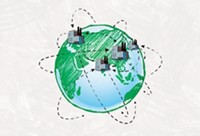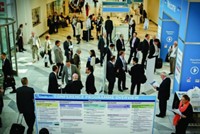Advertisement
Grab your lab coat. Let's get started
Welcome!
Welcome!
Create an account below to get 6 C&EN articles per month, receive newsletters and more - all free.
It seems this is your first time logging in online. Please enter the following information to continue.
As an ACS member you automatically get access to this site. All we need is few more details to create your reading experience.
Not you? Sign in with a different account.
Not you? Sign in with a different account.
ERROR 1
ERROR 1
ERROR 2
ERROR 2
ERROR 2
ERROR 2
ERROR 2
Password and Confirm password must match.
If you have an ACS member number, please enter it here so we can link this account to your membership. (optional)
ERROR 2
ACS values your privacy. By submitting your information, you are gaining access to C&EN and subscribing to our weekly newsletter. We use the information you provide to make your reading experience better, and we will never sell your data to third party members.
Business
Rebuilding The Supply Chain
At Informex, suppliers worked to create new and stronger ties with customers
by Ann M. Thayer with reporting by Rick Mullin
February 28, 2011
| A version of this story appeared in
Volume 89, Issue 9

The recession rocked fine chemicals companies and their life sciences industry customers, leaving all involved to take a hard look at what was left standing. Now, as customers patch up their supply chains, fine chemicals contract manufacturers are trying to make sure they have the right combination of assets and technologies to be part of the rebuilding process.
One impact of the recession is that these customers no longer take chemical supply for granted. “The focus became more on security of supply,” said Johannes Lubosch, head of raw material procurement for Bayer CropScience, at the annual Informex trade show, held in Charlotte, N.C., this month. “We did not lose business because we could not get materials, but we had to look into the details and work closer with suppliers to overcome this crisis.”
Oftentimes, new suppliers had to be found. “In various regions of the world, supply has diminished, and places where you may have sourced materials for years are no longer in existence,” added Michael Stier, director of sourcing and procurement at Austin Chemical. “You have to broaden your search, making sure you cover the whole world rather than looking at a particular geographic area.”
Along with seeking a balance between local and global suppliers, buyers have become watchful of companies’ logistical, regulatory, and environmental performance. They need to decide whether they can trust that these factors are handled satisfactorily. “If you don’t have that trust, the supply chain is at risk,” Stier commented. The overarching need, he added, has become “a combination of quality, timing, and pricing, where price isn’t necessarily the overriding factor.”
Because of new constraints on supply, flexibility and availability suddenly matter to customers. “Interest in new business definitely is thriving, and potential customers have been very busy trying to backfill products,” WeylChem U.S. Sourcing Manager Jeff Reynolds explained. “Recovery from the crisis has changed the way we do business. The availability of supply is just not as ‘on demand’ as it used to be, and we are really working hard to develop suppliers who can supply as needed.”
According to many Informex attendees, meetings at the event between customers and suppliers focused on actual projects, whereas a year ago they tended to be more informational. Nearly 500 exhibitors were looking for business at the show. Attendance was up about 5% over 2010, approaching 3,700 people. Although the overall pace was subdued, most attendees seemed optimistic.
“Business is looking good for us, and we’re seeing more proposals from new customers,” said Eric Neuffer, vice president for sales and business development at Cambrex, which offers custom manufacturing services as well as its own generic active pharmaceutical ingredients (APIs). Capabilities in niche areas, such as highly potent compounds and biocatalysis, are attracting attention, he said.
“It appears that these areas will drive growth for us going forward, not only to help our customers but also in creating new products for our generic portfolio,” Neuffer added. Although sales at Cambrex dropped about 4% in 2010, they were buoyed by a strong fourth-quarter rise of 8%.
Similarly, Albemarle had an “excellent year in 2010, with sales recovering from bad economic times in 2008 and 2009,” said David W. DeCuir, director of fine chemicals R&D. He said the firm’s contract manufacturing business is on track to double its sales this year compared with two years ago.
To complement its large-scale facilities in the U.S., Albemarle opened a lab in Belgium in late 2010 to serve European customers up through the kilogram scale. The investment “keeps relationships growing longer, locally,” DeCuir explained. To go a step further, the company is actively looking to acquire a contract manufacturing operation—preferably one outside the U.S. with commercial-scale capabilities.
Other companies have made changes to address the shifting supply landscape. For example, International Chemical Investors Group has created WeylChem International to coordinate the activities of its disparate fine chemicals activities. The new company will focus on supply chain optimization among the fine chemicals businesses and offer a range of technologies for custom manufacturing, according to Managing Director Andreas Maier. “We will have basically one face to the customer for inquiries and new product development.”
End-market diversification is another strategy. At Informex, Rhodia launched a new business unit, called Crop Protection, Health & Specialties, that develops molecules and intermediates for agrochemical, pharmaceutical, and electronics markets. And Saltigo renamed its Agro & Specialty Chemicals business unit as Agro & Fine Chemicals. The change is meant to reflect ties with markets beyond agrochemicals and drugs, such as polymers, electronics, fuel additives, and consumer products.
Indeed, a diverse customer base helped some companies survive the recession. Robinson Brothers, a U.K.-based specialty organic chemicals firm, faced what was probably the toughest year in its 142-year history in 2009, but it has seen business improve since then, according to Managing Director Adrian Hanrahan. “What kept us going was the diversity of the markets we serve,” he said.
“We’ve broken into the Chinese and the Indian markets, where we actually sell our intermediates,” Hanrahan explained. “Demand is increasing and we are getting a lot more projects from those areas.”
For SAFC, the fine chemicals arm of Sigma-Aldrich, bioscience and electronic materials businesses were the big contributors to its 9% sales growth in 2010. Operations related to small-molecule pharmaceuticals grew less robustly, although SAFC reports strong interest in its capabilities for making highly potent compounds and viral vaccines.
“In 2011, the global economy is showing some improvements, but they are still quite fragile and not homogeneous,” said Mark Cassidy, SAFC’s vice president of contract manufacturing services. One sign of promise is the return of funding to emerging drug companies, but he cautioned that it represents only modest growth in very careful and considered investments.
As for large companies, “we are seeing significantly more strategic outsourcing as big pharma recognizes its need to reduce fixed costs in development and manufacturing,” Cassidy said. These structural changes are leading to more emphasis on supply chain quality, transparency, security, on-time performance, and risk management, metrics that he believes will require “intimate and collaborative relationships.”
Efficient codevelopment and manufacturing are critical to pharma companies as they increase supply chain complexity by outsourcing more. “We are building our capabilities in a way that is strategic to serve the needs of customers,” Cassidy explained. As big pharma companies drop some of these capabilities themselves, “they need to have confidence that their suppliers and partners have a long-term strategy.”
With limited, or no, internal capabilities, many small and emerging drug firms already are almost entirely dependent on outside contract manufacturers. At the same time, major drug companies are likely to continue to increase outsourced manufacturing, said Dave Hoffman, president of U.S. operations at Portugal’s Hovione. “They will have to manage it, and they will need a plan,” he said.
According to Hoffman, mounting U.S. Food & Drug Administration pressure on drug companies to show accountability for their complete supply chains is causing them to rethink excessive reliance on manufacturers in Asia. “If U.S. and European suppliers have a reasonable cost base, there will be good opportunities for us,” he said. The cost advantage of supply from China has shrunk, given rising costs of importing and exporting materials, he added.
That said, Hovione has a long-standing presence in China. The company’s Hisyn plant in Taizhou is running at capacity, Hoffman noted. A research lab has been set up at the site, allowing the company to offer low-cost R&D to customers working on generic drugs.
Roger LaForce, general manager of marketing and sales, R&D, and logistics at Fabbrica Italiana Sintetici (FIS), the Italian producer of pharmaceutical chemicals, agrees that the typical scenario of sourcing low-cost starting materials in Asia, procuring advanced intermediates in the U.S. and Europe, and producing formulated products for local markets is breaking down.
Western firms are becoming more cost-competitive sources of starting materials, LaForce said. Like Hoffman, he believes that European and U.S. firms focused on serving emerging markets will play a key role in stabilizing pharmaceutical supply chains.
Still, firms manufacturing in Asia are expanding and emphasizing the quality of their new capabilities. India’s Navin Fluorine International is opening a pilot plant this month and a large-scale facility later this year, both of which meet current Good Manufacturing Practices (cGMP), according to Jeffrey S. Hinkle, Navin’s head of business development. The facilities were designed with the idea of providing customers with a secure low-cost source of fluorochemicals as an alternative to Chinese producers.
Asymchem Laboratories expects to open a new plant in Dunhua, China, in the second or third quarter of this year, said Jon Brice, director of business development. In what will be its largest reactors, at up to 20,000 L, the North Carolina-based firm will produce bulk raw materials, intermediates, and APIs. Having the plant operational will allow the firm to “support all portions of chemical routes at all volumes,” Brice said.
CiVentiChem, also with headquarters located in North Carolina, recently finished an audit of management systems at its manufacturing site in India. The move “qualifies our health and safety activities, helps improve our reliability, and therefore offers confidence to the marketplace for a greater scope of clients and projects,” said Glenn Killingworth, director of business development. Within the next few months, the company will open a kilogram-scale cGMP lab in Cary, N.C.
Although customer demands for greater regulatory and environmental compliance are narrowing cost differences between Asian and Western suppliers, pressures to compete on price remain. Cutting corners to keep costs down endangers the reputation of the fine chemicals industry, warned SAFC President Gilles A. Cottier, referring to past supply chain failures related to substandard ingredients and quality-control issues.
Efforts to police the pharmaceutical supply chain are focusing more recently on the quality of excipients. “Compared to APIs, excipients is a massive job,” according to Tony M. Scott, an adviser to the European Fine Chemicals Group (EFCG), part of the European Chemical Industry Council.
According to Scott, a nonprofit company called Excipact will be launched this year to maintain cGMP standards for excipients and to certify excipient suppliers. Excipact is a consortium consisting of EFCG; the International Pharmaceutical Excipients Council (IPEC) of the Americas; IPEC Europe; the European Association of Chemical Distributors; and the Pharmaceutical Quality Group, a European standards body.





Join the conversation
Contact the reporter
Submit a Letter to the Editor for publication
Engage with us on Twitter